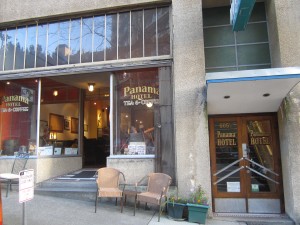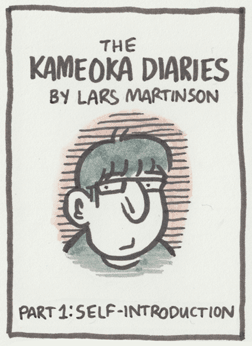WIT LIfe #202: I Wish (奇跡)
WIT Life is a periodic series written by professional Writer/Interpreter/Translator Stacy Smith (Kumamoto-ken CIR, 2000-03). She starts her day by watching Fujisankei’s newscast in Japanese, and here she shares some of the interesting tidbits and trends together with her own observations.
Over the weekend I finally got to see I Wish (奇跡), the newest English release from my favorite Japanese director, Hirokazu Kore-eda (是枝裕和). This movie is set in Kyushu, and tells the story of two brothers separated due to their parents’ divorce (one up north in Fukuoka, one down south in Kagoshima). Now that all of Kyushu is connected by bullet train, the older brother had heard it said that if you are there at the moment when two shinkansen cross (in Kumamoto, where I was a JET), you can make a wish and it will come true.
The brothers (the talented Maeda siblings, pictured here with Kore-eda) come up with wishes of their own and are accompanied by friends when they make the journey for this purpose. The original Japanese title can also be translated as “miracle”, and for many of these wishes to be realized Read More
JapanLocal: Yunohama Beach in Tsuruoka
JETAA Philadelphia Subchapter rep Rashaad Jorden recently wrote the following article for the Japan Tourist website (a great example of JETs helping to promote “local” tourism for Japan):
Yunohama Beach in Tsuruoka: Sand in the Land of Snow
While Yamagata Prefecture is famous for skiing and snowboarding, its mountains definitely don’t hold a monopoly on providing outdoor fun. Come July and August, the prefecture’s sand gets its turn to woo tourists.
Located within the Tsuruoka City limits on the Sea of Japan coast, Yunohama is Yamagata Prefecture’s most popular beach locale.
Each summer thousands of people descend upon it, albeit really only for the month-long swimming season, which starts on Marine Day weekend (Marine Day is celebrated on the third Monday of July). The roughly one kilometer beach does contain large stretches of empty sand as most beachgoers are confined to the space near the lifeguards’ chairs.
Although Yunohama doesn’t seem too different from many other beaches—big crowds on the weekend, plenty of swimmers and surfers, and lots of athletic types playing soccer and volleyball—it does offer beachgoers the convenience of not having to step off the sand in order to replenish burned calories. Stands selling, among other things, fish, takoyaki, and French fries in addition to plenty of sports drinks and soda are on the premises.
If you’re looking for something more than a suntan—or shelter from the sun in a tent (a common sight in Yunohama)—the area has more to offer. A short bicycle ride from the beach takes you to Kamo Aquarium. If dolphins don’t interest you, maybe hot water does. Yunohama is actually most famous for its onsen, as numerous signs in the Tsuruoka city center direct motorists to the popular onsen resort.
However, you can hit up the onsen any time of year. Do your best to take advantage of the limited time in summer when you can fully enjoy Yunohama.
Pratical information:
– There’s no entry fee for the beach at Yunohama, but it costs at least 800 yen to park in the nearby lots.
– Swimming season at Yunohama lasts for about only a month, starting Marine Day weekend.
CLICK HERE to read the full article on Japan Tourist and see photos.
WIT Life #201: Comfort Women (慰安婦) Controversy
WIT Life is a periodic series written by professional Writer/Interpreter/Translator Stacy Smith (Kumamoto-ken CIR, 2000-03). She starts her day by watching Fujisankei’s newscast in Japanese, and here she shares some of the interesting tidbits and trends together with her own observations.
A few days ago the New York Times featured an article about a monument in Palisades Park, New Jersey, an area populated largely by Korean Americans, dedicated to comfort women. The amount is disputed, but “comfort women” (慰安婦 or ianfu) refers to the at least tens of thousands of women and girls, many Korean, who were forced into sexual slavery by Japanese soldiers before and during World War II (Some counts put their numbers as high as 410,000).
The Palisades Park monument, built in 2010, is the only known tribute in the United States to the comfort women (Last year one was erected in Seoul, South Korea, in front of the Japanese Embassy). This picture shows three Korean Congressman who placed bouquets of white chrysanthemums at the stone monument last week.
According to the article, a delegation of four officials from Japan’s Liberal Democratic Party recently visited Palisades Park Mayor James Rotundo in order to urge him to get rid of the memorial. During this meeting they disputed Read More
I’ll Make It Myself!: Whole-Wheat Pitas (Bread Revolution Series)
L.M. Zoller (CIR Ishikawa-ken, Anamizu, 2009-11) is the editor of The Ishikawa JET Kitchen: Cooking in Japan Without a Fight. A writer and web administrator for The Art of Japan: Kanazawa and Discover Kanazawa, ze also writes I’ll Make It Myself!, a blog about food culture in Japan, and curates The Rice Cooker Chronicles, a series of essays by JETs and JET alumni on the theme of cooking/eating and being alone in Japan.
New Rice Cooker Chronicles submissions always welcome. Just e-mail it to jetwit [at] jetwit.com.

More Bread Revolution and Guide to Flour.
“Pita pockets” didn’t excite me as a kid. Toted as a kid-friendly food, the charm of stuffing sandwich fillings into a bread with a pocket was lost on me. I rediscovered pita–fresh pita–in university at Middle-Eastern diners and as (store-bought) hummus became more mainstream. In Japan, I sometimes bought stacks of pita from the import store, but after preparing for an international cooking lesson, I discovered pita are really simple to make, and more importantly, make a great bread substitute for proper sandwiches in Japan. Save the trip to the import store for chickpeas–you don’t even need to make hummus to go with it!*
I’ll Make It Myself!: My Favorite Bamboo-Shoot (Takenoko) Recipes
L.M. Zoller (CIR Ishikawa-ken, Anamizu, 2009-11) is the editor of The Ishikawa JET Kitchen: Cooking in Japan Without a Fight. A writer and web administrator for The Art of Japan: Kanazawa and Discover Kanazawa, ze also writes I’ll Make It Myself!, a blog about food culture in Japan, and curates The Rice Cooker Chronicles, a series of essays by JETs and JET alumni on the theme of cooking/eating and being alone in Japan.
New Rice Cooker Chronicles submissions always welcome. Just e-mail it to jetwit [at] jetwit.com.

Early May means fresh bamboo shoots are in season again here in Ishikawa, and I received not one but three lovely shoots from my friends and coworkers this year! 2012 is apparently a bumper year for bamboo in the forests and in my kitchen.
Whether you purchased or received fresh bamboo, one large shoot can seem like a lot to cook up. The best English-language resource for cooking bamboo is, in my opinion, Makiko Itoh’s Just Hungry. The reason why I have only one bamboo recipe on this site is because I always use hers! What I do have to offer is how to cook raw bamboo, my master list of bamboo recipes, comments, and my own photos. Enjoy!
WIT Life #200: Panama Hotel
WIT Life is a periodic series written by professional Writer/Interpreter/Translator Stacy Smith (Kumamoto-ken CIR, 2000-03). She starts her day by watching Fujisankei’s newscast in Japanese, and here she shares some of the interesting tidbits and trends together with her own observations.
I’m here in Seattle wrapping up the last leg of my ACYPL interpreting trip. After recently reading Jamie Ford’s “Hotel On the Corner of Bitter and Sweet”, I was compelled to visit the Panama Hotel which plays a pivotal role in the book. Located in the International District close to the Japanese supermarket Uwajima and bookstore Kinokuniya, this hotel with a rich history is still operating today.
It contains the only remaining Japanese public bathhouse (sento) intact in the U.S. In addition, the basement where the baths are located also houses Read More
Lars Martinson’s “Kameoka Diaries” e-comic now available on iTunes
Lars Martinson (Fukuoka-ken 2003-2006), author of the graphic novels Tonoharu: Part Two andTonoharu: Part 1, has just announced the “Kameoka Diaries“, Lars’ e-comic about his return to teaching English, this time in Kameoka, Kyoto, is now available on iTunes.
More info here and below: http://larsmartinson.com/my-first-two-e-comics-now-available/
The Kameoka Diaries: Volume One [ Direct iBookstore Link ]
The Kameoka Diaries: Volume One is a humorous (?) account of my experiences living and working in Central Japan, told over eight chapters. It includes an exclusive chapter not available anywhere else!
JETwit Note: I just downloaded a copy onto my iPhone. 250 pages for only $0.99, and I always love Lars’ work. Plus, it’s my first time using iBook which it turns out is pretty nifty. :-)
Job: Seeking a Japanese native-speaker/collaborator on book project 05.01.12
Thanks to JET Alum Justin Moy for passing on this interesting opportunity about a unique book project. Posted by Kay Monroe (Miyazaki-shi, 1995 -97).
————————————————————————————————————
Position: Japanese Collaborator for ESL Book
Posted by: Daniel Gauss
Type: Full-time
Location: N/A
Salary: Deferred pay
Start Date: N/A
Author of an ESL book to be published in the Spanish-speaking world is seeking a Japanese collaborator to tailor the book for Japanese English-learners. The purpose of the book is for learners to acquire English idioms and vocabulary through reading English instead of relying heavily on line translations. For more information about the book on Amazon, click on the following link:
Job Responsibilities:
– Write chapter introductions in Japanese
– Add introductions in Japanese to the vocabulary sections
– Write up short explanations or translations of difficult English words in the text
– Aid in changing the main character of the book to a Japanese hero or heroine (Main character is currently
a young woman from Spain studying English in New York.)
– Aid in communication with Japanese publishers to publish book in Japan
Job Requirements:
– At least a bachelor’s degree
– Proficient in written Japanese
– English teaching experience in Japan (preferred)
Compensation:
– Deferred pay (If the book is published in Japan and earns a profit, you will receive 50% of the cut.)
Note: This can be discussed, but a percentage of the profit can be donated to a charity supporting Japan.
Contact: Please send credentials to the author, Daniel Gauss, by e-mailing him at djg51qu@gmail.com.
WIT Life #199: Young Japanese Politician Power
WIT Life is a periodic series written by professional Writer/Interpreter/Translator Stacy Smith (Kumamoto-ken CIR, 2000-03). She starts her day by watching Fujisankei’s newscast in Japanese, and here she shares some of the interesting tidbits and trends together with her own observations.
I am currently in DC interpreting for a six-person delegation that is here on a two-week program with the American Council for Young Political Leaders (ACYPL). Group members represent both the DPJ and LDP, as well as one participant from the New Komeito Party. Our other destinations are Tennessee and Washington State, so despite their short stay my group will have the opportunity to experience different parts of the U.S.
Speaking of young politicians, last week the New York Times profiled Japan’s youngest mayor, 31-year old Naomichi Suzuki of Yubari, Hokkaido. Yubari is known for Read More
I’ll Make It Myself: Flour Tortillas (Bread Revolution Series)
L.M. Zoller (CIR Ishikawa-ken, Anamizu, 2009-11) is the editor of The Ishikawa JET Kitchen: Cooking in Japan Without a Fight. A writer and web administrator for The Art of Japan: Kanazawa and Discover Kanazawa, ze also writes I’ll Make It Myself!, a blog about food culture in Japan, and curates The Rice Cooker Chronicles, a series of essays by JETs and JET alumni on the theme of cooking/eating and being alone in Japan.
New Rice Cooker Chronicles submissions always welcome. Just e-mail it to jetwit [at] jetwit.com.
More Bread Revolution and Guide to Flour.

TexMex/Southwestern/Mexican foods were something I purchased from the grocery or at restaurants in the US, missed sorely in Japan, and was convinced I couldn’t make it myself. If I found salsa in a jar, I couldn’t find chips, so what was the point? Avocados weren’t something I could get my town easily, and forget cilantro or jalapeños. I gave up on my dream of enjoying these foods in Japan, but luckily Cheruko didn’t and put together a fantastic fajita spread for an international cooking lesson.
Posted by Ashley Thompson (Shizuoka-ken, 2008-2010) of Surviving in Japan: without much Japanese and Lifelines columnist for The Japan Times.
Cherry blossoms are blooming, depending on where you are in Japan, and various other types of trees and flowers are starting to show their spring colors. Graduation ceremonies are being held (or have already happened) all over Japan, as one year ends and another is about to begin.
Then there’s the pollen. Hay fever season in Japan has also arrived. And if you have allergies, it might have already hit you hard (or will…). How do you get through allergy season in Japan? You’ll find some ideas below.
A few words to know:
花粉症 かふんしょう kafunshou hay fever
花粉 かふん kafun pollen
アレルギー arerugii allergy
Now, a few ideas to help you survive hay fever season in Japan:
1. Wear a mask outside. Even if you didn’t wear one in your home country, “do as the locals do” or “when in Rome…” or something like that. I personally can’t stand wearing them, but I know some people who now like wearing them.
2. Use a mask spray. Apparently if you spray your mask with this stuff it makes the mask more effective at keeping unwanted particles out.
3. Try a “nose mask” – (pictured below) It’s basically something that you attach to the underside of your nose and each side goes in a nostril. It acts as a filter for pollen and other airborne particles.

4. Refill those allergy medicine prescriptions. It is possible to get Claritin, Allegra, Zyrtec and Flonase (フルナーズ) in Japan – consult a doctor about possibilities. You could also try contacting Japan Healthcare Info if you’re not sure where to look or who to ask. Some possible prescription non-drowsy or “mostly” non-drowsy meds in Japan include: Allegra (アレグラ), Claritin (クラリチン), Alesion (アレジオン), エバステル, Talion (タリオン), and Zyrtec (ジルテック). [Source]
You can get some over-the-counter anti-allergy medication, but most, if not all, are drowsy, and probably not as effective as those you can get by prescription. (Let us know, though, if you’ve found something that works well and isn’t too sleep-inducing). Mmmfruit mentioned Zaditen as an option. David and I have both used Stonarhini (ストナリニ), and while David didn’t get too drowsy, I felt like I had just taken a Benadryl (it knocked me out for hours). It claims to use less of the ingredients that make you drowsy, but it may be best to try it on a day you don’t have to go out and do anything, just to see how your body reacts first. — CLICK HERE to read 11 more ways to defeat hay fever this year.
 Australian JET alum Pepi Ronalds (Miyagi-ken, Sendai Shi, 2010-11) recently published an essay on Amazon titled “After Shock: Experiencing the 2011 Japanese Earthquake.” Below is a bit of context from Ronalds along with an extract from the essay:
Australian JET alum Pepi Ronalds (Miyagi-ken, Sendai Shi, 2010-11) recently published an essay on Amazon titled “After Shock: Experiencing the 2011 Japanese Earthquake.” Below is a bit of context from Ronalds along with an extract from the essay:
About Pepi
Pepi is a freelance writer, ghostwriter and researcher based in Melbourne, Australia. On any given day she is found writing, researching and craving sakuranbo soft-cream from the Omiyage shop below Yamadera. While working as an ALT in Sendai Shi, Miyagi prefecture she experienced the Great East Japan Earthquake first hand. She writes about the experience in her long-form article After Shock: Experiencing the 2011 Japanese Earthquake, which can be downloaded via Amazon or Pepi’s website http://www.pepironalds.com.
“After finishing JET I returned to the freelance writing career that I had begun in late 2009. As a writer of non-fiction, I was keen to write about my experience of the triple disaster in Sendai. I knew that many people outside of Japan had a limited understanding of what had happened. – Yes, I was caught up in a natural disaster as a foreigner, and yes it was scary. But there was (and continues to be) so much more to my experience (and those of my fellow JETs and gaijins). I was astounded by the incredible generosity of my Japanese friends and colleagues, and the work they’ve done (and are doing) to rebuild.”
As publishing paradigms change, I there are fewer venues for long-form articles like mine. So in publishing this article I made my first foray into ‘entrepreneurial journalism’. That is, I am selling direct to readers. Below is an extract. If you want to read the whole thing (6,500 words) you can either download the article via Amazon, or buy direct from me using Paypal.”
Extract from After Shock: Experiencing the 2011 Japanese Earthquake
“We started the heaters,” my friend Yuriko writes, “but we are trying not to use them often to save them in case of an emergency.” I know the school in Sendai to which she refers. Winter is marked by a meter of snow on the baseball field. It’s sustained by snowflakes the size of marshmallows that seem to fall horizontally. The winds wheeze and rattle at loose windows. When I was there last year, I was constantly dabbing my nose with a tissue. And when my friend writes this from Sendai eight months after the earthquake, winter in Japan has barely begun.
I read her email and think back to that frigid Friday, March 11, 2011. My students and I were decorating the walls of the school with a mosaic of origami-paper blossoms. It was so cold in the unheated hallway that my fingers seemed to move in slow motion. We worked with a feeling of purpose and excitement. Then there was a long, deep, foreboding yawp. An announcement from the earth beneath us that everything was about to change. Read More
I’ll Make It Myself!: Easy Whole-Wheat Pizza Dough (Bread Revolution Series)
L.M. Zoller (CIR Ishikawa-ken, Anamizu, 2009-11) is the editor of The Ishikawa JET Kitchen: Cooking in Japan Without a Fight. A writer and web administrator for The Art of Japan: Kanazawa and Discover Kanazawa, ze also writes I’ll Make It Myself!, a blog about food culture in Japan, and curates The Rice Cooker Chronicles, a series of essays by JETs and JET alumni on the theme of cooking/eating and being alone in Japan.
New Rice Cooker Chronicles submissions always welcome. Just e-mail it to jetwit [at] jetwit.com.
One thing that always amazes me when I return to the US is the sheer amount of choice one has about food. Order a pizza in the US and you can usually choose whole-wheat or white crust (sometimes even gluten-free); thick or thin crust; marinara sauce or white sauce; any combination of toppings. With the sheer amount of kinds of pizzerias in towns like Ann Arbor–everything from national chains to Silvio’s organic pizza–the sky was the limit.

I know most of my posts start with me gushing about Ann Arbor, then complaining about Japan, then resolving into my resolution to make it myself, but going from choosing the tiniest details of my pizza to angrily eyeing the corn-and-mayo pizza on a rare trip to Coco’s actually wasn’t that shocking until I came back to the US on business in the winter.
WIT Life #198: Japan’s Economic Woes
WIT Life is a periodic series written by professional Writer/Interpreter/Translator Stacy Smith (Kumamoto-ken CIR, 2000-03). She starts her day by watching Fujisankei’s newscast in Japanese, and here she shares some of the interesting tidbits and trends together with her own observations.
Today’s New York Times features two article regarding Japan’s economic doldrums. The one from Martin Fackler talks about Japan’s decline as a manufacturer, and what direction the new course the country should take will be. The other by Hiroko Tabuchi discusses the fate of one of the manufacturers mentioned in Fackler’s article, Sony. Kazuo Hirai joined as the new CEO at the beginning of this month, and it remains to be seen what path he is planning to take the company on. Many commentators throughout say that Sony has failed to differentiate itself, and the article closes with the quote, “The tarnish on their brand has definitely begun.” Happy reading!
Surviving in Japan: The Ultimate Guide to Reading Food Labels
Posted by Ashley Thompson (Shizuoka-ken, 2008-2010) of Surviving in Japan: without much Japanese and Lifelines columnist for The Japan Times.

When I first came to Japan, attempting to read food labels and understand what things were and what was IN what I was buying and eating was a huge obstacle. I could read hiragana, katakana and some kanji, but the majority of the food labels were confusing and I spent extensive amounts of time at the supermarket, smartphone in hand with a Japanese-English dictionary open, trying to decipher ingredients and information. I’d also use the smartphone app, ShinKanji, to search for various kanji and words I couldn’t read.
The work paid off, and though now I can’t read every single Japanese word without consulting a J-E dictionary or looking up certain kanji, I can usually quickly scan most labels to find what I want to know.
A guide to reading food labels in Japan is also one of the most popular post topic requests I’ve received. It’s something most of us struggle with when we first arrive, and I’d imagine even some of those who are fluent may not have known every word or kanji at first. Deciphering Japanese food labels, the entirety of them anyway, isn’t particularly easy, but I’ve attempted to break them down for you here. Note that I have not covered various ingredients aside from common allergens, as that’s something to cover in a separate post (or more than one). This one is already long!
I should note that food labels in Japan aren’t always consistent, as you’ll see below, and although, for example, you’ll usually see information about the total calories, protein, fat, carbohydrates and similar main nutrients, you won’t always see much about other minerals or vitamins (though things like fortified cereals, breads, etc., often list these).
I’ve also tried to include a variety of words you’ll see, but some terms/phrases are worded slightly different, although the meaning is generally the same, e.g., “賞味期限” and “消費期限” both mean “best before; best eaten by” or the expiration date.
Also note that throughout the post I have not broken down kanji and words as I normally do – instead, the vocabulary charts break them down, so please reference the charts for a breakdown. (You can also use the “find” feature on your browser and copy/paste a word you want to see in the chart to find it quickly.)
So let’s get on with it: how do you read food labels in Japan?
— CLICK HERE for the following:
Japanese Food Label Vocabulary Chart
Japanese Nutritional Information Vocabulary Chart
How to Understand the Nutritional Information List on a Food Label
How to Understand the Rest of the Food Label
How to Read Food Labels on Imported Goods
Meat and Seafood Labels
Fruit and Vegetable Labels
Allergy Information on Food Labels


